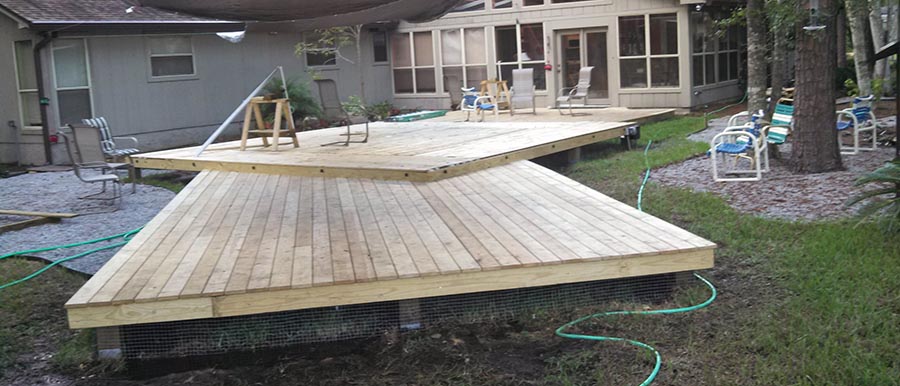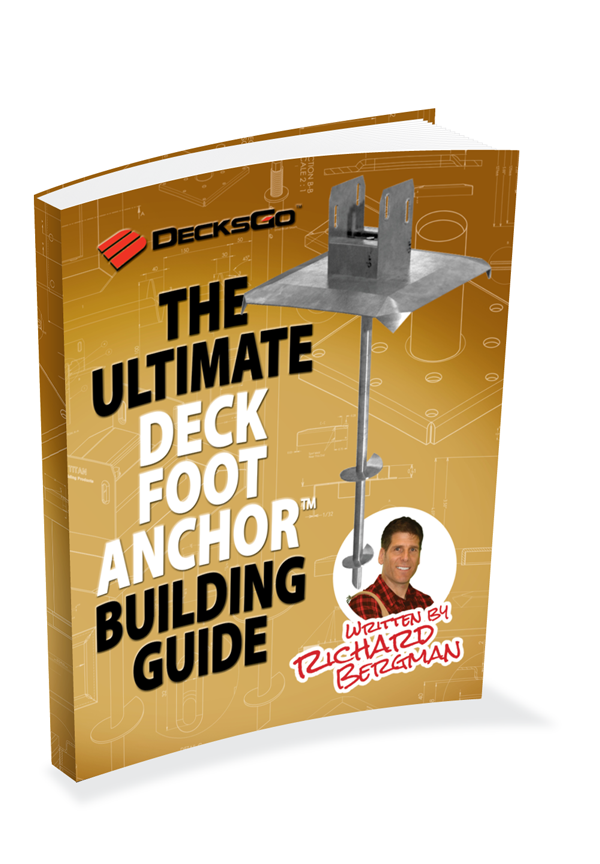building a massive ground level deck with the titan deck foot anchor™
How an ordinary diy'er built a massive three tiered ground level deck the easy way - and you can too.
This backyard deck was a beast of a job. But it was the perfect candidate for the Deck Foot Anchor™.
The soil was good. No rocks to speak of. Maybe a few small roots but no significant obstructions.
There was no need to connect this deck to the ledger and deal with the extra work and details that would require.
Concrete deck blocks were not permitted because of wind lift concerns along the Florida coast. It had to be securely anchored to the ground.
For all these reasons, the Deck Foot Anchor™ was a great solution and now this otherwise undesirable job was now a realistic possibility for an average do it yourself homeowner.
about the builder

Jim is from Jacksonville, Florida and he built this massive (1200 sqft plus) three tiered ground level deck using thirty Titan Deck Foot Anchors.
The Guy Next Door
He is just an ordinary home owner - probably just like you - and he was facing a huge labor project if he was going to use concrete footings.
No Desire To Dig Holes
Jim had no desire to break his back in
the hot Florida sun digging and mixing cement plus setting hardware for
dozens of footings. Nor did he want to pay that much for materials or
hire a crew.
Are you in the same situation as jim?
When you are looking at a job site as large as this and you factor in the idea of working for a day or two at least digging, setting forms, back filling, mixing and pouring cement, it really makes you think.
Jim had some pretty ambitious plans for three ground level decks staggered and layered over each other to create a floating appearance. He knew that if he wanted to pull this off on his own, he desperately needed a solution.
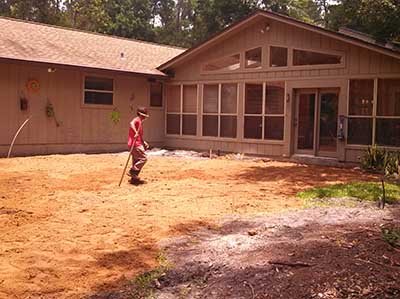
Prepare The Site And Use batter boards for footing locations
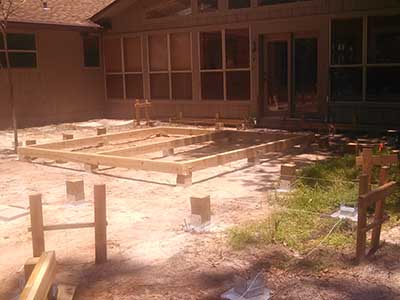
The first thing that needs to be done is to level the site or at least the locations of the footing. This site was already nice and level.
Using batter boards will really help you align your footing locations perfectly. And if you find you cannot drive a footing down in one location, you can retract the auger and move it along the string line and try again.
Batter boards make this a lot easier to do.
Hanging joists flush with perimeter joists
If you look closely you might see something a bit different about the way Jim framed this deck. There are no beams.
Or another way of saying it is that the beams are the perimeter joists. And then all the in field joists are hung against the sides of the beams for a flush finish.
This little trick will save you at least 8" of elevation because beams and joists are in the same plane.
This drawing does not mimic exactly how Jim has done his framing but it does show clearly the idea of hanging joists from the sides of a common beam that is resting on the footings.
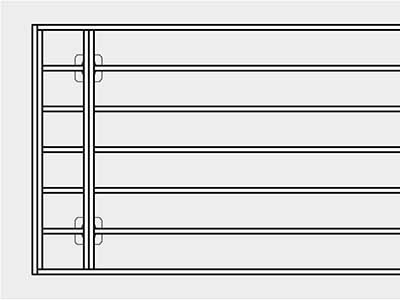
If you want to save some height and get your deck as low to the ground as possible, this is the way to go.
significantly Reduce The Elevation Of Deck
This point deserves a really good illustration. The larger image below makes it very clear how you can reduce the elevation by hanging joists flush with the tops of the beams.
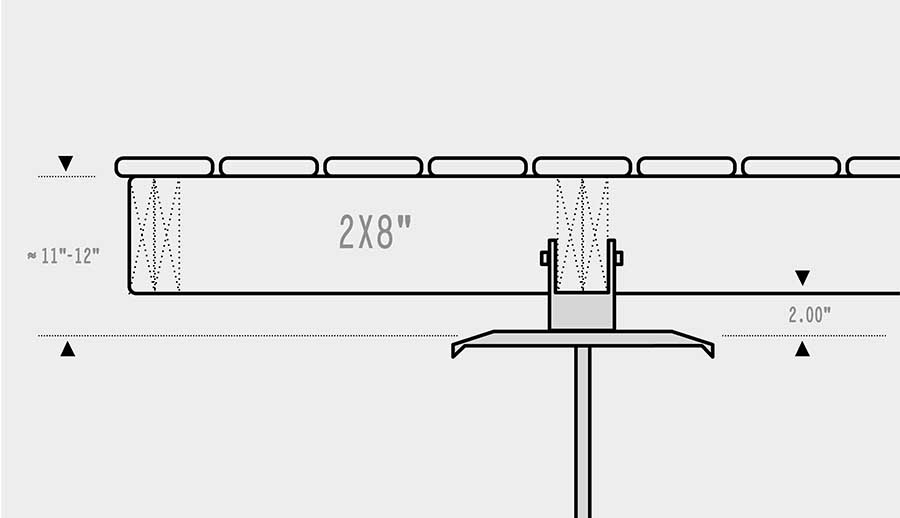
The underside of the joists can be as little as 2" above grade. The top of the deck can be less than 12" above grade and you could cantilever the deck as much as 24"(but 18" is probably best) beyond the footing to completely hide them.
layering, Alternating decking and orientation of decks
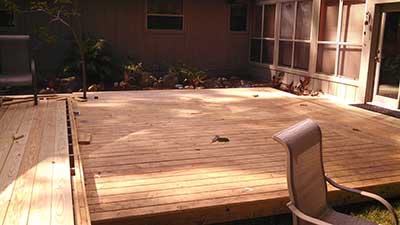
Check out how Jim was able to easily set the finished elevation of this first deck just below the sill plate of the patio doors.
He also used a technique we often recommend which you should take note of and that is to alternate the direction of the decking from one deck to the next.
It can really differentiate each deck.
As you look away from the house and to the second and third deck you can see the effect of the alternating decking, the elevation differences and the orientation of each platform. This is wonderful way to build large deck structure without creating something that is visually oppressive.
The property is large and so a tiny little deck would not work well either.
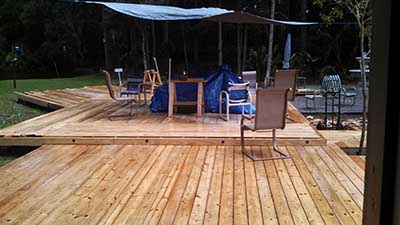
watch Jim Drive The Deck Foot Anchor Down
Just drive the anchor down using an electric impact wrench. It does all the work. Now, to be sure, if your site is full of rocks and roots you may not have the same experience. There is no silver bullet for rock laden soil except digging.
But you get a clear sense of how this works and the kind of relief and sense of accomplishment Jim had on this massive deck that he built all by himself.
why jim used the deck foot anchor instead of deck blocks
You might be wondering why you would use the Deck Foot Anchor instead of $10 concrete deck blocks because both distribute load to the surface. Here are some of the main reasons.
Less Deck Foot Anchors Than Deck Blocks
You can use less Deck Foot Anchors than deck blocks because of the larger surface area.there fore less deck foot anchors than block.
Superior Wind Resistance
A lot of people are unaware that deck blocks are not allowed in many parts of the country where high winds are a concern unless you chain or strap the deck to ground spikes. That is a big hassle. Whereas, the Deck Foot Anchor installed in undisturbed soil provides superior uplift resistance to a deck block.
Easier To Build Lower Ground Level Decks
The Deck Foot Anchor allows for deck framing to be set much lower because of the lower profile post saddle. Deck blocks sit higher up and so you would have to dig holes to recess each deck block to try to achieve the same thing.
A Stronger Deck
When you use the Deck Foot Anchor the entire deck frame, beams and posts are firmly secured to the footings which in turn are secured to the ground so the deck itself cannot easily move or rack or torque like it can when resting by its own weight on deck blocks.
More Value For Your Money
When you are done, you end up with a deck structure that is stronger, securely connected to the ground, resists greater wind lift and performs similarly to a deck on concrete footings.
built in Error protection with the new lateral slide aperture
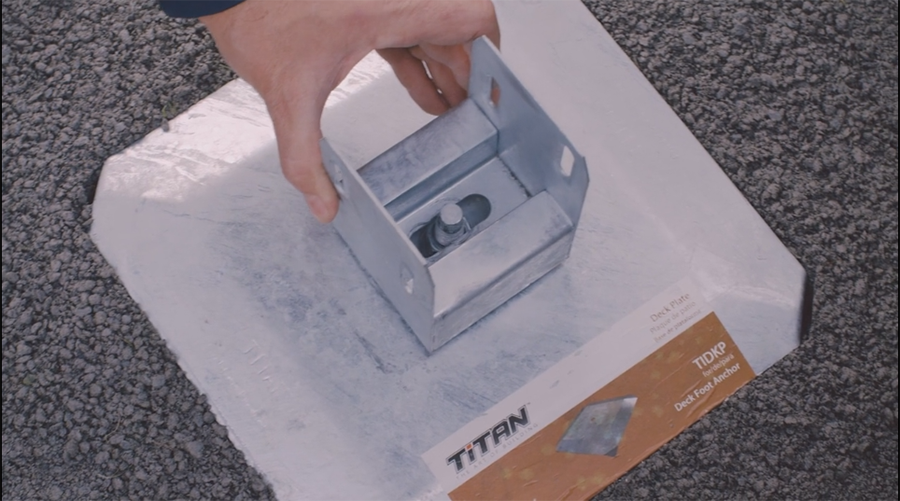
The new lateral slide feature allows the post saddle to move up to 2-½" laterally in case you are not able to drive the anchor down in the exact location you wanted. This also comes in handy when you want to set a beam directly on the saddle supported by three or more footings.
frost and uplift not a problem: watch closely
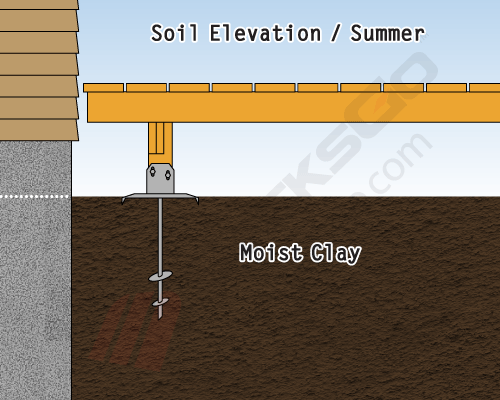
Using a 24" auger
Here is how the deck anchor works in colder freezing climates. This shows a 24" auger completely within the frost zone of the soil. The entire deck "floats" as the soil expands when frozen and contracts when thawed. Your deck has to be free standing and not attached to the ledger.
Notice that the auger itself does not and cannot "heave" like a fence post might. But the large surface area of the load plate acts similar to an elevator platform.
using a 36" auger
You might think a longer auger would make a difference. But it does not and this is because the lifting force of the soil when it freezes will lift anything sitting on it because the load plate is so large.
A longer auger is a good idea if you are building on sandy soil or on sloped terrain or you have severe wind storms in your area and you want even more uplift resistance.
Of course none of this matters to Jim because he resides in sunny Florida. Lucky guy!
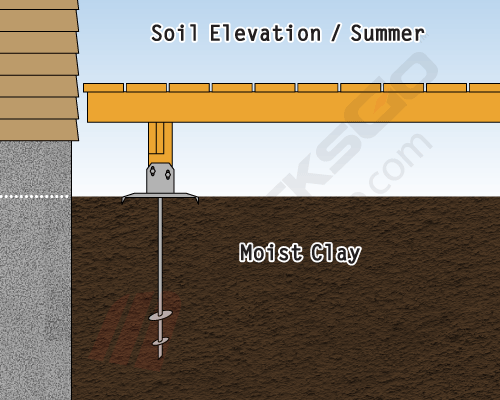
Is your site suitable for the deck foot anchor?
Now, one last word of advice, because we never want to guide anyone down the wrong path. If you think you want to use the deck foot anchor for a ground level deck like this one that Jim built and you are worried that you might have poor soil that is full of rocks, why not test your soil first?
Here Is How To Test Your Soil
Take a
piece of re-bar and drive it down into your soil in a few spots and see
if it goes down easy or hits a rock. Use a sledge hammer and them pull
it out by hand. Yes it is a bit of work.
Or buy one of our single augers an test it out to be sure. You don't have to invest in a dozen footings unless you are confident.
Jim reached out to us to tell us what he thought
"Greetings. My deck anchors were probably one of the best 'buys' I had made for my DIY projects..My son is now about to build a deck and I would like to use this product for his project as well. Are you still manufacturing them? Please let me know."
Jim Aires - Jacksonville, FLA
Yes, Jim we are still manufacturing the Deck Foot Anchor and more now than ever. We are gradually starting to get local stores carrying the product now that they see how many people want this available locally. But until there is a store in your neighborhood we can get it to your door by UPS anytime you need.
A project like this is within your reach
We feature real customers that placed their confidence in us and used the Deck Foot Anchor and took the time to reach out and contact us to tell us about their experience. Hopefully this case study has helped you out.
It's alright to feel excited. You should be. This kind of a project is within your reach. Now go build that deck!

The Deck Foot Anchor™ is a DecksGo Recommended Product. It's one that we are confident you will be happy with. It's been tested in some of the harshest cold and sweltering heat temperatures and it has proven to be as tough as nails.
DecksGo was the first company to bring this product to the market, and you can expect more great "first" moments like this.
This is what we do - try to bring you leading edge building solutions before anyone else.
Home > Deck Foot Forum > Case Study: Ground Level Deck





















